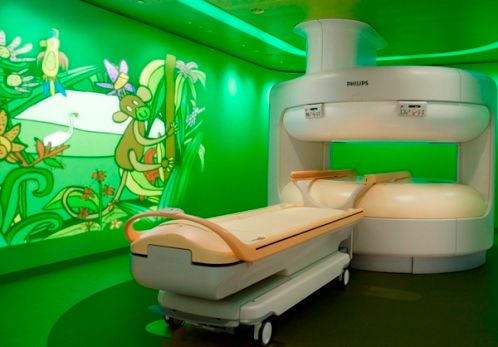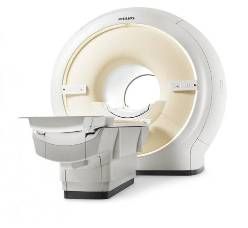MRI Machines Becoming More Patient-Friendly
New patient-friendly MRIs with 0.3T offer more options for scanning larger patients, children, extremities, as well as people with claustrophobia.
Imagine telling your patients you can conduct their MRI in a tranquil meadow, under the ocean, or any location they find relaxing. What do you think they’d say about reading their favorite book during the scan? There’s a chance they’d be much happier about being subjected to the scan.
Patient-friendly MRIs aren’t new, but they’ve generally given you poor-quality images. There’s a new generation of machines on the market now, and they offer more room and high-resolution scans.
“New scanners offer huge benefits in both comfort and quality,” said William Morrison, MD, associate radiology professor at Thomas Jefferson University Jefferson Medical College. “Some machines allow us to only focus on extremities, and others are helpful for people who suffer with claustrophobia. Newer scanners also enable us to scan larger patients.”
Arms, Legs, Wrists, and Ankles
There are times, especially if you have athletic patients, when you only need to scan a small body area, such as an ankle or wrist. In those situations, sliding a patient into a traditional MRI machine isn’t your best option, Morrison said, because image quality is poor in those areas.
Instead, extremity scanners target particular spots and produce high-quality scans.
“Patients appreciate these scanners because they aren’t stuck inside a tight-fitting tube,” he said, referring to the GE Optima MR430 scanner GE-produced extremity scanner used at Thomas Jefferson University Hospital. “It’s fantastic for people with claustrophobia, and it’s good for kids because they get to have their parent right there beside them.”
As an added benefit, it’s cheaper to run extremity scanners than traditional MRI machines, he said.
Scanning Children
But for some patients, especially children, simply having their head outside the MRI isn’t enough to make them comfortable and calm.
“Children are easily intimated by medical equipment and rooms that look overly clinical,” said Jeffrey Foster, MD, radiology-in-chief in the pediatric radiology department at Kosair Children’s Hospital in Louisville, Ky. “If you can help control their anxiety, they won’t be as afraid, and you’ll be less likely to have to use any sedation to keep them still.”
Kosair uses an MRI system called Ambient Experience from Philips Healthcare to put children at ease. According to Deepak Molharta, Premium MRI general manager for Philips, the system, which uses an open scanner, can project relaxing scenes and soothing colors onto the walls, and children can play with a miniature version of the Ambient Experience scanner - called a “kitten scanner” - and send a toy for an MRI before they enter the exam room.

Photos Courtesy Philips Healthcare
Whether children respond to the colors, the scenes, the toys, or even to the option of having a parent in the scanner with them, Foster said, open MRI technology is a positive turn for both patients and radiologists. Open MRIs are open on all four sides. Imagine a large doughnut suspended over another large doughnut, attached by a hinge or console.
“After doing this for 20 years, there’s no question about it, these patient-friendly advances do make a difference,” he said. “The benefits might be intangible at times, but it does help.”
Claustrophobic and Larger Patients
Patient-friendly technology has also addressed comfort concerns for claustrophobic and overweight patients. The 55 cm to 60 cm bore size is no longer the industry standard. Instead, vendors now produce MRI machines with 70 cm bores that can both alleviate claustrophobia and make scanning heavier patients easier. That extra 10 cm (roughly 4 inches) reduces the “trapped” feeling some feel inside the MRI, and it lets you scan patients who weigh up to 550 pounds. Some MRI models also have shorter tubes so a patient’s head is never enclosed.
Making traditional MRI experiences more comfortable can also bolster your bottom line, said Milind Dhamankar, Siemens Healthcare’s senior director of MRI marketing.
“Having a machine that scans obese patients could add revenue to your center since there is a pandemic of obesity in this country,” he said. “It’s also possible that you’ll be able to successfully scan more patients who are frightened of the enclosed MRI tube.”

Recent research supports Dhamankar’s assertion. A BioMed Central Medical Imaging study from Germany’s University of Humboldt showed patients abort approximately 2 million MRIs annually due to claustrophobia. It’s the equivalent of losing $1.4 million in yearly productivity.
However, the same study found larger bore size fails for 25 percent of claustrophobic patients. If you have patients with severe fears, you could opt for an open high-field scanner, similar to the one in Philips Ambient Experience. Think of them as an Oreo cookie without the cream - the MRI machine has a top and bottom but no sides, and the patient slides in between.
What Makes It Work
Until recently, any open MRIs gave you substandard imaging. However, boosted Tesla strength and parallel imaging are two technology changes that have fixed this problem. The switch from 0.2 to 0.3 Tesla scans to ones using 1.5 to 3.0 Tesla has significantly improved the scanning quality, said Vamsi Narra, MD, chief of radiology at Barnes-Jewish West County Hospital in St. Louis.
“With improved Tesla, we’re getting stronger field strength and more signal, so moving the magnets further away from the body is no longer a problem,” Narra said. “With the older, low-field strength MRIs, we got crappy images, and we were never really able to look at the chest, heat, belly, or abdomen.”
Barnes-Jewish recently acquired a Siemens MAGETOM Espree scanner.
The advent of parallel imaging has also made undergoing an MRI scan less daunting for patients. With parallel imaging, technicians use multiple receiver coils to speed up the process of gathering images, which means more images in less time. By truncating scan time - sometimes by as much as 50 percent - parallel imaging reduces the length of time patients must remain still for the scan. This is particularly beneficial for patients who are unable to hold their breath for long periods of time.
“In the industry, we’re looking to increase patient comfort by improving all the technology we can,” Philip’s Molharta said. “It’s certainly a challenge, but it’s incumbent upon all of us to provide the least stressful experience possible.”
MRI Study at ARRS Raises Questions About Disparities in Detection of MASLD
May 3rd 2025New research revealed that Hispanic Americans with evidence of hepatic steatosis on MRI but no formal diagnosis of MASLD had over a fourfold higher risk of developing hepatocellular carcinoma in comparison to those who had a formal diagnosis of MASLD.